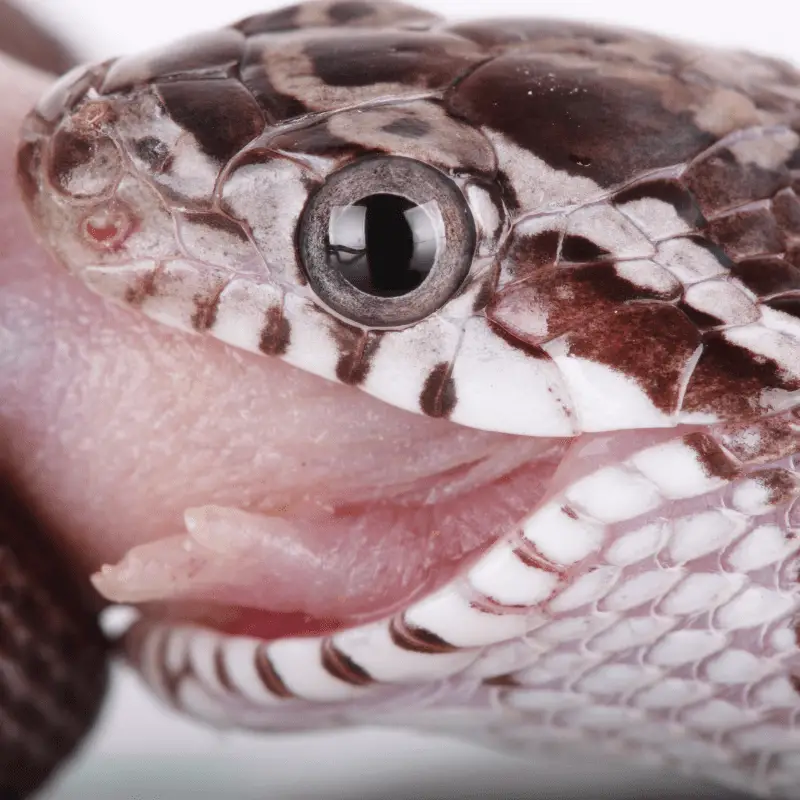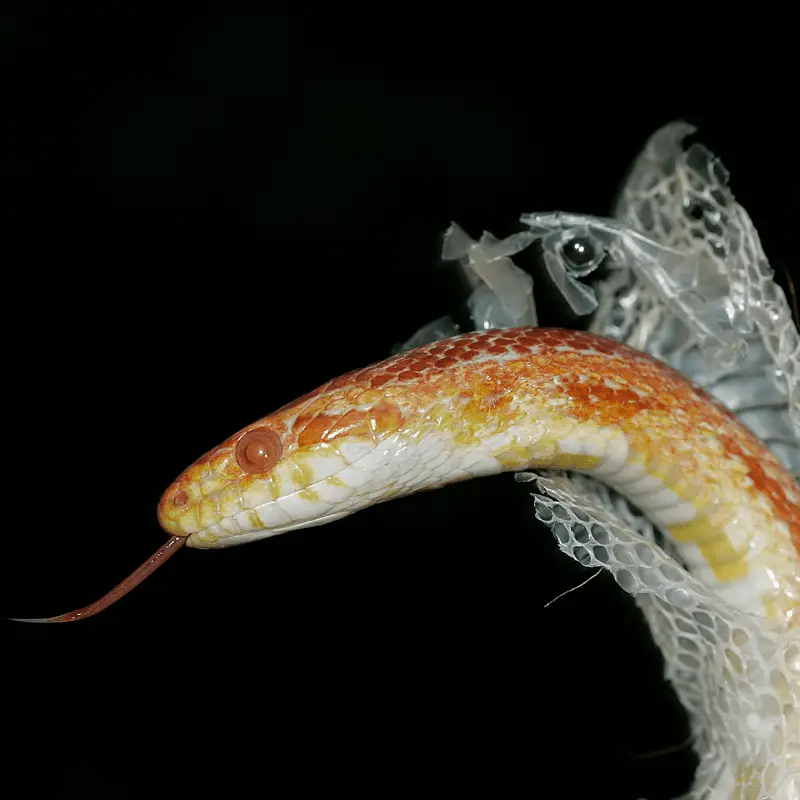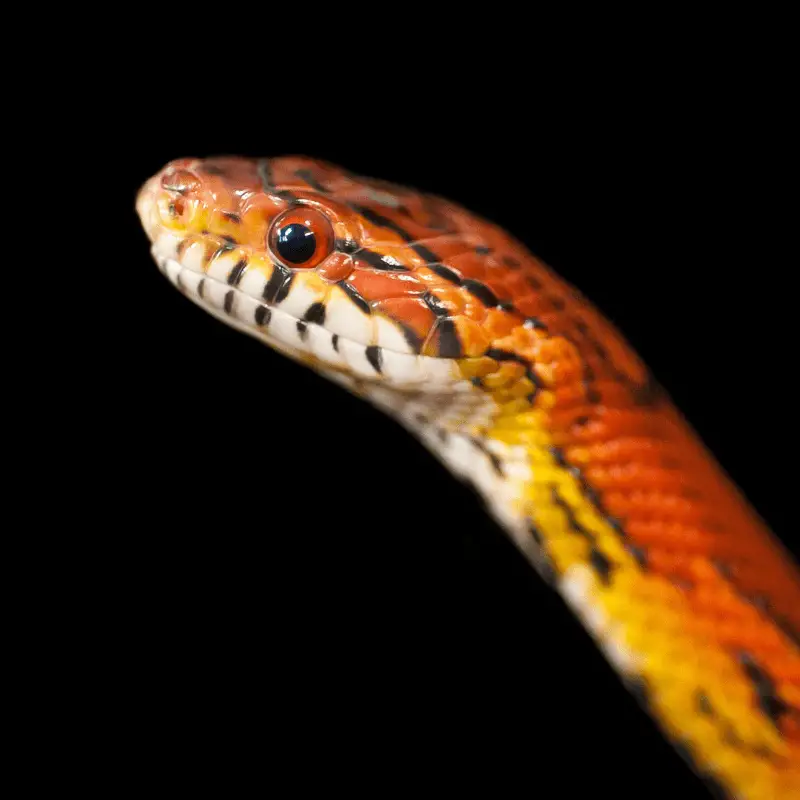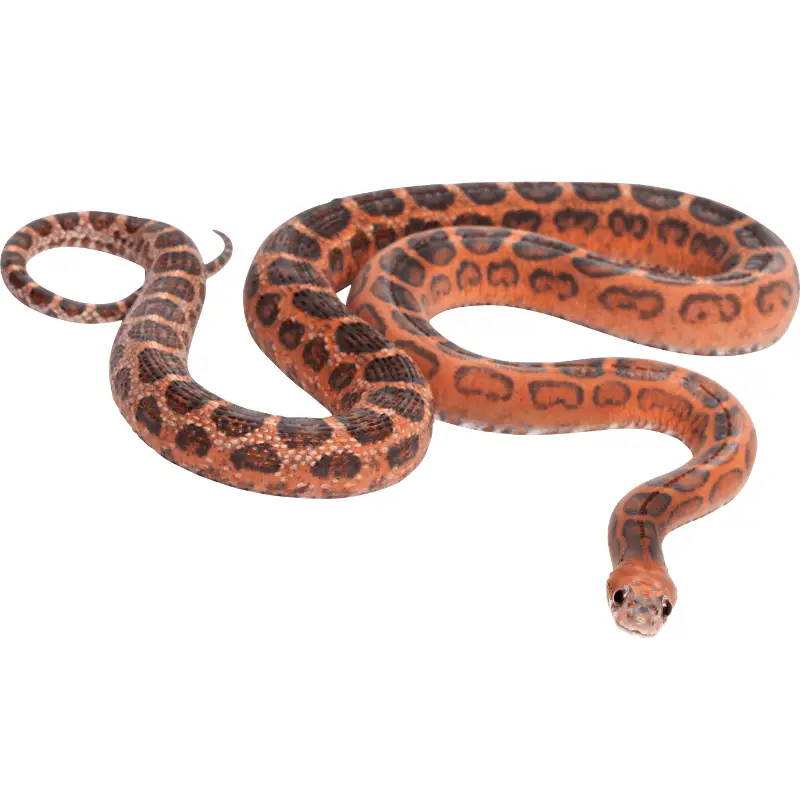The corn snake is one of the most colourful and docile snakes you can find in the United States. Its nature and appearance have made corn snakes one of the most popular reptiles. Not only that, a corn snake is considered one of the most popular choices in the pet industry.
Their availability, beauty, moderate size, and most importantly, docile nature have made these snakes popular among snake keepers. Corn snakes can be your best choice if you are beginning your journey as a snake keeper. The best thing about corn snakes is that they thrive in captivity. That quality makes the corn snakes one of the best pets.
Like the goldfishes, parakeets, and hamsters, prominent corn snakes come with unique colours of even albino markings. However, the herpetologists disapprove of keeping corn snakes as a pet. The reason is that corn snakes can escape from their terrarium, which is quite common.
Once they escape, the corn snakes can threaten the native population by introducing harmful genetic materials that have been artificially selected in a captive snake.
The snake’s common name is, most likely, derived from its similarity with the colour and patterns of the Indian corn snake. Even though there is a belief that the snake’s name is derived from its diet or habitat, it is not valid. These snakes are sometimes known as red rat snakes. This name is derived depending on the preferred diet of the snake.
Species Overview
- Scientific Name: Elaphe guttata
- Family: Colubridae
- Size: The average size of the snake is between 3 to 5 feet. The male snakes often grow more significant than the female ones.
- Life Expectancy: in captivity, these snakes can live for 15-20 years. However, in the wild, the life expectancy of the snakes is much lower.
Location
The corn snakes are widely found from the southern section of New Jersey to Virginia. However, the central range of the corn snakes is located in the North Carolina region.
From there, these snakes can be found in the Florida Keys. The corn snakes can also found in the areas extending from Southern Tennesse to Eastern Lousiana. There is also a detached population of corn snakes available in the Kentucky region. Even though corn snakes can be found throughout all these areas, their availability in the mountains and piedmont is much less than in coastal areas.
Habitat
Most of the time, the corn snakes are spotted in the terrestrial upland zones exposed, dry, and full of subterranean mammal burrows. These snakes especially favour the sandy pinewood areas. Thanks to their docile temperament, the corn snakes are tolerant of human disturbance.
That is why you can spot these snakes in agricultural lands or suburban regions. Other than that, these snakes are often found in barns and old buildings, as there are plenty of rats available for them. Sometimes, these snakes enter people’s homes while following the prey.
Appearance
The dorsal side of the corn snakes is orange in colour. However, some snakes can come with grey, reddish or brownish dorsal sides. In addition, most of the snakes have black margined squarish reddish or brownish blotches marked with black margins. Most corn snakes come with a row of 30 to 50 squarish blotches or patterns spread all over their bodies.
The slender snake has a spear-shaped blotch on the top of its head, which points to the snake’s nose. The first blotch is generally connected with the spear-like shape. The last blotch usually appears on the tip of the tail, turning the snake look even more appealing. All the blotches or the shapes are outlined with dark brown or black colour, whereas the central section of the marks ranges from orange, red, brown to a combination of all three.
The belly side of the snake is chequered with black and white markings, which has a strong resemblance to the piano keyboard. In addition, the snake comes with black stripes on both sides of the tail. Finally, these snakes also have a black stripe from the back of their eyes to the corner of their jaws.
Thanks to their similar appearance, corn snakes are often mistaken for venomous copperhead snakes. However, you have to keep in mind that the copper heads have hour glass like blotches on their bodies instead of the squarish marks like the corn snakes.
The glossy scales have weak keels in the adult corn snakes, which is not seen in juvenile ones. In addition, unlike most snakes, the flat sides of the belly of the corn snakes meet their body sides while forming an angle. This physical adaptation is one of the reasons why they are so adept at climbing trees or constructions.
History and Threats
In the 1700s, the famous naturalist Mark Catesby first described the existence of corn snakes. These snakes are still not listed under any of the unique protection lists. However, the population of corn snakes has declined significantly in the last few years. The destruction of habitat, fragmentation, and alteration of the natural elements has dramatically impacted these snakes’ well-being.
The unregulated collection of snakes for commercial purpose is also harming their population. Other than this, a large number of snakes become victims of road kills every year. Yet, despite these prevalent threats, these snakes are pretty common in most of North Carolina.
Habits
When following prey, these snakes can climb up a tree quite easily. However, you can find these snakes on the ground as well. The corn snakes are nocturnal. That is one of the reasons why they are one of the most common victims of road kills. During the daytime, these snakes often hide under dead trees or logs. They also take refuge in rodent burrows or stump holes in the pine forests. Old construction sites full of abundant materials and other debris are the most common places to encounter corn snakes.
When they are alarmed or frightened, the corn snakes try to escape from the situation instead of getting confrontational. However, the cornered corn snake may sometimes perform a defence posture. In this case, the snake keeps on vibrating their tails and strikes out to the attacker repeatedly.
Like all the other snakes in the North Carolina region, corn snakes also secrete a foul-smelling musk from the glands situated on the base of their tails. The corn snakes like to chase their prey and kill them when they are active. They generally feed on mice, rats, other small mammals, and birds. These snakes first kill their prey through constriction and then swallow them whole.

The natural predators of the corn snakes include carnivorous mammals and birds, like a hawk. Other snakes, like the black racers and king snakes, hunt the corn snakes as their food. The corn snakes prefer to hibernate in the burrows below the frost lines during the winter months. However, on warmer days, you can spot the snake basking in the sun.
Life Span
The life span of corn snakes varies significantly in captivity. The snakes kept as pets live a better, happier, and longer life than those held in the breeding colonies. The oldest corn snake in captivity lived for thirty-two years and three months.
The corn snakes that are kept in various zoos regularly pass the mark of twenty years. The snakes in the wild, of course, do not live for as long. So, if you are thinking about getting a corn snake as a pet, understand that you are in for a long haul.
Bite
The teeth of the corn snakes are generally arranged in two separate semi-circular rows on their top and bottom jaws. These snakes also have rows of sharp teeth on the top of their mouth. However, being docile, these snakes rarely bite.
However, some corn snakes never lose their juvenile nippy behaviour and keep their biting habit intact. As a result, the bite of the corn snakes is generally not serious. Most of the time, the bite marks are nothing more than just a couple of pin-pricks.
Reproduction
The breeding season for the corn snakes starts from the early spring and lasts till May. These snakes are oviparous by nature. That denotes that the female corn snakes lay eggs that hatch on later dates. From May to July, the females lay 10 to 30 eggs inside the rotting stumps of the trees.
Other than that, heaps of decomposed vegetation or other related locations are used by the female snakes for the same purpose. The humidity and the heat of these places help the eggs to hatch at the right time. The adult corn snakes do not care for their eggs. So, once the eggs are hatched, the hatchlings need to deal with the problems on their own. It takes 18 to 36 months for the hatchlings to reach maturity.
Sleeping Habits
The corn snakes are not that active like other snakes. Most of the time, they spend resting or sleeping. Being secretive, most of the time, they spend in their hiding place. You can find the corn snakes lounging on the tree branches quite often. However, on rare occasions, the corn snakes are found lying on the open ground as well.
From time to time, the snake tries to explore their habitat. This behaviour is noted both during the day as well as the nighttime. Mostly, the corn snakes get active when they are hungry. However, seasonal changes can also affect them, and they can also change their activity patterns before their shedding cycle.

Shedding
Just like all other snakes, the corn snakes also shed their skins from time to time. Their shedding is, of course, associated with their growth, but it also enables them to repair their wounds or damaged scales. The shedding process goes on for about a week. However, the snakes living in arid conditions may face problems while shedding.
Morphs
Here are some of the common morphs of corn snakes that are popular in the pet industry.
Okeetee Corn Snake

The Okeetee corn snake is considered the perfect corn snake in the pet industry. Most of the Okeetee corn snakes come with red blotches that are surrounded by pitch-black borders. In addition, the base body colour of these snakes can range from bright orange to russet.
Miami Phase Corn Snake

The names of many corn snakes are decided on their native region. The Miami corns got their names in the same manner. These corn snakes generally showcase silver-grey base colour with a touch of orange or dusting. The dorsal blotches of the snake can be defined as more orange than red. Compared to the other corn snakes, the Miami corns are smaller in size.
Housing the Corn Snake
For the corn snakes, you should arrange for a 20-gallon glass tank. As the corn snakes are the expert escape artists, you should place a super tight lid to keep the snake inside their enclosure. Herp owners must clamp down the cover from the top of the enclosure.
The corn snakes require hiding places to feel safe. That means you should provide them with a hiding box in the enclosure. You can use an upside-down cardboard box as a make-shift hide box for your snake. Just make sure that the box is large enough for the snake to curl up in it.
If the hiding box is too large, the snake may not feel secure while hiding inside it. You can also use small pieces of tree bark for creating a natural hiding place for your snakes. However, it would help if you kept some substrate in the enclosure so that the snake can burrow itself under the bark. You should create two separate hiding places in the cooler and the warmer hiding places in the enclosure. Also, do not forget to keep a forked branch of a tree for climbing.

